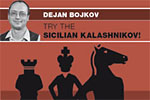
Bojkov: Try the Sicilian Kalashnikov
A review by Albert Silver
Openings DVDs, much like openings books, come in a wide variety of shapes and forms, or rather, quality and plans. They range from those that try to give only the broadest ideas with a minimum of theory à la Reti’s “The Ideas Behind the Openings” while others seem like the recitation of a section of an openings encyclopedia. As a player, my needs fall right in between the two as I am no longer weak enough to survive just on ideas, nor strong enough to fill in all that is unsaid in theory-heavy works. When I saw the very friendly title “
Try the Sicilian Kalashnikov” by GM Dejan Bojkov, it sounded like this was going to be a very light work.
GM Dejan Bojkov, long-time coach of GM Antoaneta Stefanova, is anything if not thorough, and judging from the work, one imagines he must be quite the coach. In the introductory video, he explains that the opening is one of the most recent major variations to be added to top theory and is a bastard brother to the Sveshnikov. It is ideally suited for players who do not want to contend with a boatload of theory, have rich options for personal exploration, and a variety of strategic approaches. Promising. He then expounds his course plan, dividing the DVD into two parts. The first will supply sample games chosen to illustrate the major themes and ideas of the opening, while the second will supply concrete theory to give exact answers to exact situations. Even more promising, but will the execution live up to it?
The table of contents of the DVD corresponds to his outline with no fewer than 32 individual videos awaiting me. The first on the list almost astonishes: Historical journey: McDonnell,A - De Labourdonnais,L. Almost all authors are content to mention where an opening stems from when they do even that, but the Bulgarian GM guides us through the first famous historic game to use the ideas, and then explains when it began to be properly accepted at the dawn of the 1990s. This is also the student’s first experience with Bojkov as a presenter, and we are immediately put at ease: his delivery is fluent and practiced, there are no problems understanding him and he knows the material and what he plans to say.
The games he chooses to illustrate the themes and plans are all well chosen, and any worries about murky examples overridden with too much happening are dismissed. He also takes the time to highlight important ideas that can be useful throughout the game.
For example, in 13. Endgames with outpost on d5, in which he uses Oll-Dvoirys (1990), after he reaches 24.a4 Rc7

GM Dejan Bojkov tells the student to specifically memorize certain plans and ideas
He explains that it is a good idea to stop and memorize this defensive method. Black’s rook not only gets out of the way from a white knight attack from b6, but also prepares Nc8 to exchange off a white knight invasion on b6, protect d6, and allow the king to join via e7.
Even in situations such as after 28.Bg4

Black’s reply 28…Na7!

is explained so that the flexibility of ideas behind it is made clear, preventing White from exchanging off the strong knight, and preparing alternately Nb5 if White plays a5, or ...b5 supported by the knight on a7.

The themes extend to the types of endgames and what to watch
out for.
The second half of the DVD, the theory section, is what one would expect, and each main line is broken down in detail using important games to demonstrate the theory. The videos are not rushed, though unless you are already familiar with the theory of the lines, you will probably be viewing them more than once.
In his farewell, Bojkov concludes with the usual well-wishes for success and enjoyment, but also adds the names of players whose games he feels are bound to be instructive for further ideas on plans and theory.
I’ll be honest, I am not your biggest openings theory fanatic (understatement of the year), so I will not give you a list of credentials explaining how I have been playing it for the last twenty years, and am secretly consulted by the world’s elite for my insights. That said, I am a demanding consumer and am not usually enthusiastic about openings works as they rarely strike the right balance for me, or deliver with a consistently high standard. GM Dejan Bojkov’s DVD on the Kalashnikov, spanning six hours, does so on all fronts, and players of a wide range of strengths should be able to get something from it. I was very impressed overall, and highly recommend it.
Copyright
ChessBase




























